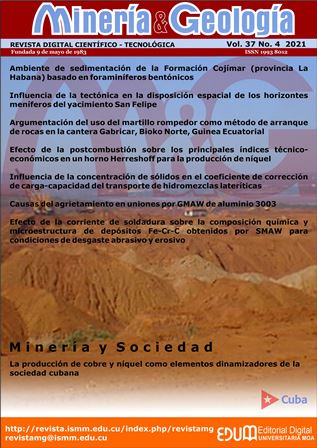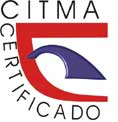Using the jackhammer as rock digging method in Gabricar quarry, North Bioko, Equatorial Guinea
Keywords:
mining, rock digging, quarrying, jackhammer, basalt rocks.Abstract
Blasting and drilling methods are mainly used in basalt rock quarries as blasting-digging methods. The purpose of this study is to argue the validity of using a jackhammer as a rock removal method in Gabricar quarry, based on knowing the geomechanical parameters of rocks as well as the technical-economic indicators for exploitation. Gravimetric, saturation, hydrostatic weighing, pycnometric and axial loads methods were used to obtain physical-mechanical properties of the rocks and geological survey, volumetric joint count, and strength coefficient were used to establish crack elements, block size, and rock mass quality, respectively. 4.75% humidity; 2.39% porosity; 5.73 g/cm3 volumetric mass; density of 26.44 g/cm3 and axial compressive strength of 173.53 Mpa as average values of physical-mechanical properties were obtained. Four families of cracks with spacing of 0.4m, 0.6m; 0.3m and 0.2m and 18mm openings; 13mm; 3mm and 9mm, respectively were established. Blocks are small and the rocky massif is of good quality. The technical-economic analysis showed the efficiency of the jackhammer as a blasting-based digging method in Gabricar quarry.Downloads
References
ASTM-D2216. 2015: Métodos de Ensayo para Laboratorio para Determinar Contenido de Agua (Humedad) en Suelos y Rocas por masa.
Atkinson, W. 1977: Selection of Open Pit Excavating & Loading Equipment, Transaction Institute of Mining & Metallurgy – Section A, pp. A101 – A129.
Bindang, M. 2014: Actualización del Plan de Rehabilitación en la Cantera de Izaguirre. Trabajo de Diploma. Universidad Nacional de Guinea Ecuatorial, Malabo, Guinea Ecuatorial.
Chacin, F. 2000: Diseño y análisis de experimentos I. Editorial. FEPUVA-UCV. Caracas, Venezuela.
Freund, J., & Simona, G. 1992: Modern Statistics. 8 Ed. Editorial Prentice Hall. New Jersey. USA.
Hernández, N. 2015: Procedimiento para la elección del método de arranque de las rocas en canteras para áridos. (Tesis Doctoral), ISMMM, Moa, Cuba.
Brown, E.T (Ed) 1981: Rock Characterization, Testing and Monitoring. ISRM Suggested Methods :Pergamon, London, 211 p.
Noa, R. 2003: Indicaciones metodológicas para la elección del método de arranque de las rocas durante el laboreo de excavaciones subterráneas horizontales de pequeña y mediana sección en cuba oriental. (Tesis Doctoral), Instituto Superior Minero Metalúrgico, Moa, Cuba.
Nsue, G. B. 2016: Argumentación del método de arranque en la cantera de Gabricar. (Trabajo de Diploma), Universidad Nacional de Guinea Ecuatorial, Malabo, Guinea Ecuatorial.
Palmström, A. 2005: Measurements of and correlations between block size and rock quality designation (RQD). Tunnelling and Underground Space Technology, 20 (4) :362-377.
Pettifer, G. S., & Fookes, P. G. 1994: A Revision of the Graphical Method for Assessing the Excavatability of Rock, Quarterly Journal of Engineering Geology and Hydrogeology, 27 (2) :145 – 164.
Protodiaconov, M. 1962: Methods of studying the strength of rocks used in the U.S.S.R., in International Symposium on Mining Research, New York.
Published
How to Cite
Issue
Section
- Authors retain copyright and guaranteeing the right magazine to be the first publication of the work as licensed under a Creative Commons Attribution-NonCommercial that allows others to share the work with an acknowledgment of the work's authorship and initial publication in this journal.
- Authors may establish separate supplemental agreements for the exclusive distribution version of the work published in the journal (eg, place it in an institutional repository or publish it in a book), with an acknowledgment of its initial publication in this journal.
- Authors are allowed and recommended to disseminate their work through the Internet (e.g., in institutional telematic archives or on their websites) before and during the submission process, which can produce interesting exchanges and increase citations of the published work. (See The effect of open access)










